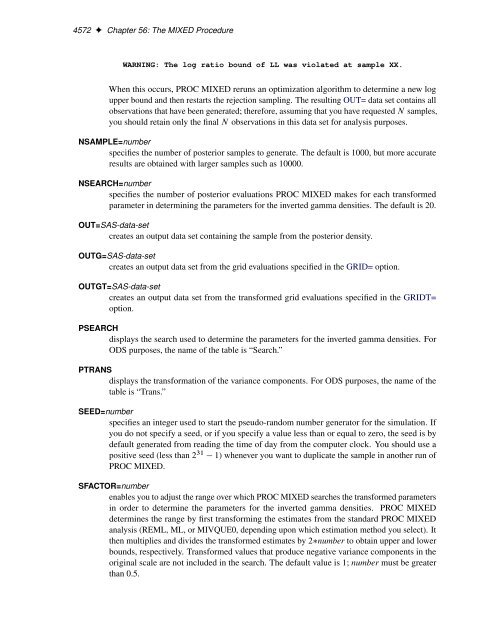SAS/STAT 922 User's Guide: The MIXED Procedure (Book Excerpt)
SAS/STAT 922 User's Guide: The MIXED Procedure (Book Excerpt)
SAS/STAT 922 User's Guide: The MIXED Procedure (Book Excerpt)
Create successful ePaper yourself
Turn your PDF publications into a flip-book with our unique Google optimized e-Paper software.
4572 ✦ Chapter 56: <strong>The</strong> <strong>MIXED</strong> <strong>Procedure</strong><br />
WARNING: <strong>The</strong> log ratio bound of LL was violated at sample XX.<br />
When this occurs, PROC <strong>MIXED</strong> reruns an optimization algorithm to determine a new log<br />
upper bound and then restarts the rejection sampling. <strong>The</strong> resulting OUT= data set contains all<br />
observations that have been generated; therefore, assuming that you have requested N samples,<br />
you should retain only the final N observations in this data set for analysis purposes.<br />
NSAMPLE=number<br />
specifies the number of posterior samples to generate. <strong>The</strong> default is 1000, but more accurate<br />
results are obtained with larger samples such as 10000.<br />
NSEARCH=number<br />
specifies the number of posterior evaluations PROC <strong>MIXED</strong> makes for each transformed<br />
parameter in determining the parameters for the inverted gamma densities. <strong>The</strong> default is 20.<br />
OUT=<strong>SAS</strong>-data-set<br />
creates an output data set containing the sample from the posterior density.<br />
OUTG=<strong>SAS</strong>-data-set<br />
creates an output data set from the grid evaluations specified in the GRID= option.<br />
OUTGT=<strong>SAS</strong>-data-set<br />
creates an output data set from the transformed grid evaluations specified in the GRIDT=<br />
option.<br />
PSEARCH<br />
displays the search used to determine the parameters for the inverted gamma densities. For<br />
ODS purposes, the name of the table is “Search.”<br />
PTRANS<br />
displays the transformation of the variance components. For ODS purposes, the name of the<br />
table is “Trans.”<br />
SEED=number<br />
specifies an integer used to start the pseudo-random number generator for the simulation. If<br />
you do not specify a seed, or if you specify a value less than or equal to zero, the seed is by<br />
default generated from reading the time of day from the computer clock. You should use a<br />
positive seed (less than 2 31 1) whenever you want to duplicate the sample in another run of<br />
PROC <strong>MIXED</strong>.<br />
SFACTOR=number<br />
enables you to adjust the range over which PROC <strong>MIXED</strong> searches the transformed parameters<br />
in order to determine the parameters for the inverted gamma densities. PROC <strong>MIXED</strong><br />
determines the range by first transforming the estimates from the standard PROC <strong>MIXED</strong><br />
analysis (REML, ML, or MIVQUE0, depending upon which estimation method you select). It<br />
then multiplies and divides the transformed estimates by 2 number to obtain upper and lower<br />
bounds, respectively. Transformed values that produce negative variance components in the<br />
original scale are not included in the search. <strong>The</strong> default value is 1; number must be greater<br />
than 0.5.

















